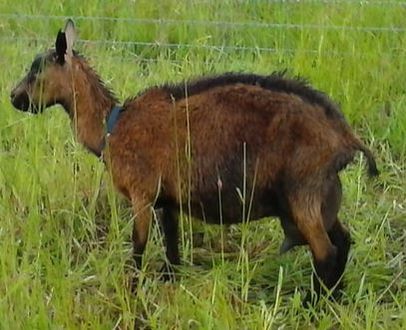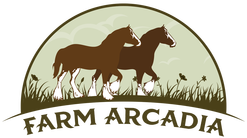 I would suspect that anemia is one of the more common health problems among small ruminants of sheep and goats. With dairy breeds, they are high-performance milk producers and can feel the impact of anemia very hard. This picture is of one of my goats I brought home after buying her knowing she was joining us severely anemic. She's a little wet because she didn't seek shelter in a morning drizzle, something I remedied right away after taking her picture. I'm sure there is a lot to know anemia, but here is the little information I have that might help out a few other homesteaders. Why It Matters Anemia means to not have enough red blood cells. Red blood cells carry oxygen to the cells, which is REQUIRED for cell metabolism. This means cells need it to carry out regular maintenance of cell walls and produce energy and building blocks for living. Without enough oxygen, cells live in a state of starvation. How severe depends on how bad the anemia is and the demands placed on the body. Anemia causes animals (and people) to be unthrifty, unproductive, and can lead to their gradual demise and death. For the dairy animal, she will loose weight, have poor appetite, under-lactate both in quantity and quality (nutrient makeup), get bullied, have weaker babies, have complications when lambing / kidding, and be susceptible to other illnesses and injuries. Causes & PreventionMy experience has been that the number one problem causing anemia is parasitic infestation. Farm animals have parasites, also know as "worms." This is a natural part of eating pasture. However, when the parasites become too prolific, they consume whole blood faster than the animal can generate it. This includes the red blood cells of anemia, but also blood proteins and nutrients they've absorbed. Essentially, the animal has gone through all the work to get energy and nutrients delivered to their organs and cells, but it's being stolen. Poor feed, stress (like weather), deficiencies, exposure to a lot of parasites, and other factors can contribute to anemia. To prevent anemia, I deworm regularly. I've read to do it only for those affected (testing their stool) or to do it herd-wide. I do some of both. I don't deworm every month or two, though I do twice a year without testing. If I find a specific animal that needs it, I will give it to her in addition to the other times. That really only happens when I acquire new animals. (A note on acquiring them: I don't seek out sick animals, but it's common for owners to simply not know why to deworm and what anemia looks like.) Planting certain things in the pasture help keep parasitic populations at bay. I'm not going to list them here because they may be good for one and not for another. For example, pine needles are beloved by my goats and are reported to keep parasite population contained. However, if cattle eat pine needles third trimester, there is a thing call pine needle poisoning that causes premature labor and abortion of the calf. Most of these plants I believe are safe for all ruminants and are herbaceous (leafy) instead of grasses. Please note that these plants do NOT cure infestation, but help keep it under control. That goes for diatomaceous earth, too, from my experience. (It can be irritating for some animals.) Detection My assessment of dear Marjoram in the picture above:
Also of note is that she is still producing milk. Don't wait for milk production to stop to look for anemia. Treatment Keep in mind that in humans, it takes about four weeks for a new red blood cell to enter circulation. Treating anemia will take at least four weeks for a good recovery, but I find it takes longer for a full recovery because her body isn't fully revved up the first week or two. Plan on six to eight weeks of focused treatment with extra vigilance after that, usually forever after that..
Step 1: For severely anemic lactating girls, I dry them off. I don't care if it's early in the season or late, her health is my first priority. She needs to start getting better now. For moderate to slightly anemic, I go on a case by case basis. If she's underweight or sickly, dry her off. If she's still fat or medium, she can lactate. If she has twins or triplets, I may supplement them so the demand on her isn't as severe. Step 2: Deworm mildly to aggressively, depending on severity of anemia. Your inclination may be to blast their system with all the anthelminthic treatments possible, but this is not always ideal. As the parasites let go in the digestive tracts, it is likely that the animal's blood doesn't have enough platelets and clotting factors (specific proteins) to clot off quickly. So, she may bleed into her digestive tract: anemia + bleeding = not good. I give her a minimum dose amount of something that has wide resistance such as albendazole or fenbendazole. The goal is to knock down the parasitic infestation gradually. If she is not severely anemic, I am more aggressive in my treatment. While continuing other treatment, I may deworm her with something else in a few days and a good strong combination around the one week mark with a follow up strong combination at the three week mark. Be aware of milk withholding times if you are consuming her milk. Step 3: Supplement. For goats, I pop them a slow-release bolus of copper. Copper deficiency is a little akin to iron deficiency in humans ... sort of. I've also read that the copper rods are a little anthelminthic themselves, though I don't know for sure. I also give them an injection of vitamin B and of A, D & E. If I have selenium (Bo-Se), I give her some of that, too, which is usually where the vitamin E comes from. If she's only mildly anemic, I may go all oral. I make sure she has access to minerals at all time and I may give her an oral gel. Depending on how she looks, I may do that every week or so ... the oral not the injections. I find the vitamin B helps with the brain fog a little. I don't have evidence to show that, but it seems to help a little. Step 4: Shelter, feed, water. I set her up in a dry sheltered area with everything she needs right in reach so there is no unneeded expenditure of energy to get food or water. I will give her softer leafier hay rather than stemmier hay. I gradually give her more grain. I will even add fat to her diet such as sunflower seed oil or other vegetable oil on her grain. I'm not above enticing her with molasses. She needs calories and nutrients. If she is walking around and such, I still give her extra grain and oil, but leave her with her herd or flock. Step 5: Keep monitoring her. Once she has become severely anemic, they never seem quite the same. She doesn't necessarily need to be culled, but does need a little extra care and closer eye to catch it early if it starts to happen again. She may produce just as well, but my experience is that there is some permanent damage in there. They also seem to bond with me more for having helped them when they were sick.
2 Comments
Kristen
6/4/2022 02:51:23 pm
Hi Mindy,
Reply
Saundra Baxter
9/17/2023 05:18:58 pm
Just the info I was looking for, so thank you for taking the time to share. I have a total of 4 lambs (25% of this years') with bottle jaw and one anemic doeling that I bought at auction for a $1, because I had to try. I have done most of what you suggested, though may have been too aggressive with the wormers. I know for next time, though I'll fight to avoid it. Thanks again!
Reply
Your comment will be posted after it is approved.
Leave a Reply. |
Mindy HelmsWife to Brandon, mother to Tess and Liam, farmer, entrepreneur, cook & baker, nurse, and accountant who loves to try new things, travel, and work toward greater self-reliance. Archives
May 2024
Categories
All
|

 RSS Feed
RSS Feed
